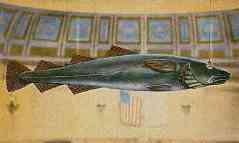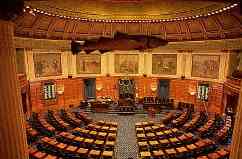
The Sacred Cod of Massachusetts.
Theft is one of the classic and most-often-used tools in the toolbox of college pranksters. All manner of prized items are regularly spirited away at campuses throughout the world: statues, bells, trophies, road signs, etc. But precisely because theft is such an obvious form of pranksterism, it has an extra hurdle to overcome in order to achieve originality. Nevertheless, originality can be achieved in two ways — either through the ingenuity of the method of theft, or, as in the case of the Sacred Cod of Massachusetts, through the novelty of the object stolen.
A Plan Is Hatched

Another view of the Sacred Cod in the
Massachusetts House of Representatives
The "Sacred Cod" of Massachusetts (that's really what it's called) is a five-foot long codfish carved out of pine that hangs suspended above the entrance to the chamber of the House of Representatives in the Massachusetts State House. A wooden codfish has hung above the Massachusetts State legislators ever since the eighteenth century, as a symbol of the importance of the cod to the early economy of the region.
Some might see the decision of the Massachusetts legislature to deliberate beneath a wooden cod as just a charming eccentricity, but the 1933 staff of the Harvard
Lampoon (Harvard's monthly humor magazine) saw it as a gauntlet thrown down. They decided they had to possess that cod.
Stealing The Cod
The
Lampoon's plan of action had two prongs: diversion and frontal assault. The diversionary tactics went into effect first.
They knew that the main obstacle between them and the successful completion of their task was not the Boston police, but rather a source closer to home: the
Harvard Crimson (Harvard's daily newspaper). The staff of
The Crimson and
The Lampoon had long been fierce rivals, never missing an opportunity to take each other down a notch.
The Lampoon knew that if given the chance,
The Crimson would do everything in its power to sabotage
The Lampoon's plans. Therefore,
The Crimson could not be allowed to have any inkling of what was to happen. A diversion was needed to distract its attention.
On Wednesday April 26, 1933, editors from
The Lampoon created a diversion by raiding the offices of
The Crimson and kidnapping J.M. Boyd, a
Crimson staff member. They spirited him away to a secret location off campus. This infuriated the other
Crimson staffers, who promptly focused all their attention on finding Boyd.
While
The Crimson was thus occupied, the frontal assault on the cod began. The plan of attack was disarmingly simple. Three
Lampoon staffers walked into the state house armed with a pair of clippers and a flower box. They waited until a discreet moment when no tourists were around. Then they quickly clipped the wires holding up the fish, tucked it away in their flower box, and disappeared.
The Search for the Cod
An anonymous call tipped off reporters that the cod was gone, and immediately all hell broke loose. The newspapers worked overtime gushing forth hyperventilated prose about the blasphemy of "cod-napping" such a sacred relic. State police were called in to assist with the search. The Charles River was dragged.
A second caller phoned the Mayor's office and left a taunting message: "Tell the Mayor that when the Sacred Cod is returned it will be wrapped in the municipal flag, now flying in front of City Hall. Try and catch us when we cop the flag."
The state legislators were uncertain whether they should return to session without the Cod, but they decided to convene anyway. Before banging the gavel to bring the house to order, Speaker Saltonstall looked mournfully at the place where the Cod used to hang. Throughout the day, the legislators debated what the harshest possible charges were that could be brought against the fish thieves.
Meanwhile rumors and speculation about the whereabouts of the cod spread wildly. For two days the police raced around the city following wild "red herring" leads. But almost immediately suspicion focused on
The Lampoon staff. Witnesses at the state house at the time of the theft reported seeing a group of young men hanging around decked out in white saddle sport shoes, in the style of Harvard students. In addition, one of the young men was said to have been visibly drunk. Someone else remembered a young man walking away carrying a long box from which lilies protruded — presumably the box containing the Cod. Who else could the culprits be but the staff of
The Lampoon, the police figured.
The Lampoon, when confronted with this accusation, issued a not-quite-straight-faced denial, while simultaneously congratulating whoever had done it. They didn't flinch even when state authorities pointed out that the punishment for disfiguring a monument was a year and a half imprisonment, a $100 fine, or both.
When one of
The Lampoon staff boarded a plane to Philadelphia, detectives phoned ahead and had him detained upon his arrival. The police questioned him for hours, until they were convinced he had no knowledge of the whereabouts of the fish.
The Cod Restored
Finally, on the night of Friday, April 28, Chief of Harvard College Police Charley Apted received an anonymous tip informing him that if he wanted to get the cod back, he should go to the West Roxbury Parkway and follow a car without license plates. Apted dutifully followed these instructions. After 20 minutes, the car pulled into a forest where two young men, their collars turned up and hats pulled down, leaped out and handed Apted the Cod.
Apted immediately returned the Cod to the House of Representatives. It had been missing for a total of fifty hours.
The Commonwealth of Massachusetts breathed a sigh of relief to have its sacred cod back. With the fishy divinity safely hanging back in its accustomed place, all talk of finding and prosecuting the culprits quickly subsided. No charges were ever brought against anyone. The only permanent consequence of the prank was that the sacred cod was hung six inches higher, in an effort to place it beyond the reach of future generations of Lampooners.
Sacred Cod Poem
The following poem about the theft of the sacred cod appeared in the
Los Angeles Times on May 16, 1933:
THE PILFERED COD
By James J. Montague
From Winthrop Beach to Bunker Hill,
From Cambridge to Revere,
The voice of happiness was still,
One heard no note of cheer.
A pallor whitened every face.
All eyes were red and swollen;
A dreadful crime had taken place —
The Codfish had been stolen.
The Fish that symbolized a trade
Which, in the days of old,
The shores of old New England made
A strand of shining gold,
The Fish that millions came to view
With ardent admiration,
The Fish whose fame has echoed to
The Corners of the nation.
When first I set my roving feet
Upon Bostonian sod,
I hastened blithely up the street
To view the Sacred Cod,
And in its dull and glassy eyes,
The instant of our meeting,
I fancied that I saw arise
A glance of cordial greeting.
Today there is an end of grief;
No more the skies loom black;
A chastened and repentant thief
Has brought the Codfish back.
No Stygian gloom now broods around,
No heart with woe is freighted;
Bostonian pulses leap and bound —
The Cod is reinstated.
Sacred Cod Trivia
• The Sacred Code hung in the old State House until 1793, at which time it was moved to the House of Representatives in the Bulfinch State House. In 1895, when the House moved to a new chamber, four messengers bore it, wrapped in the American flag, to its new home above the speaker's chair.
• Traditionally, the head of the cod points at whichever party is currently in power.
• The sacred cod once (before the 1930s) appeared on Massachusetts license plates. It was removed following complaints that the image on the plates in no way resembled a cod.
• According to rumor, the words "In Cod We Trust" are carved into the Sacred Cod. There is no evidence that this is true.
Links and References
- "Bay State Sacred Cod gone without a trace." (Apr 28, 1933). Los Angeles Times.
- "Bay State's Cod Back in Shrine." (Apr 30, 1933). Los Angeles Times.
- "Sacred Cod Theft Laid to Lampoon." (April 28, 1933). The New York Times.
- "Sacred Cod back in honored place." (April 29, 1933). The New York Times.
- Neil Steinberg. (1992). If at all possible, involve a cow. St. Martin's Press: 82-85.




Comments